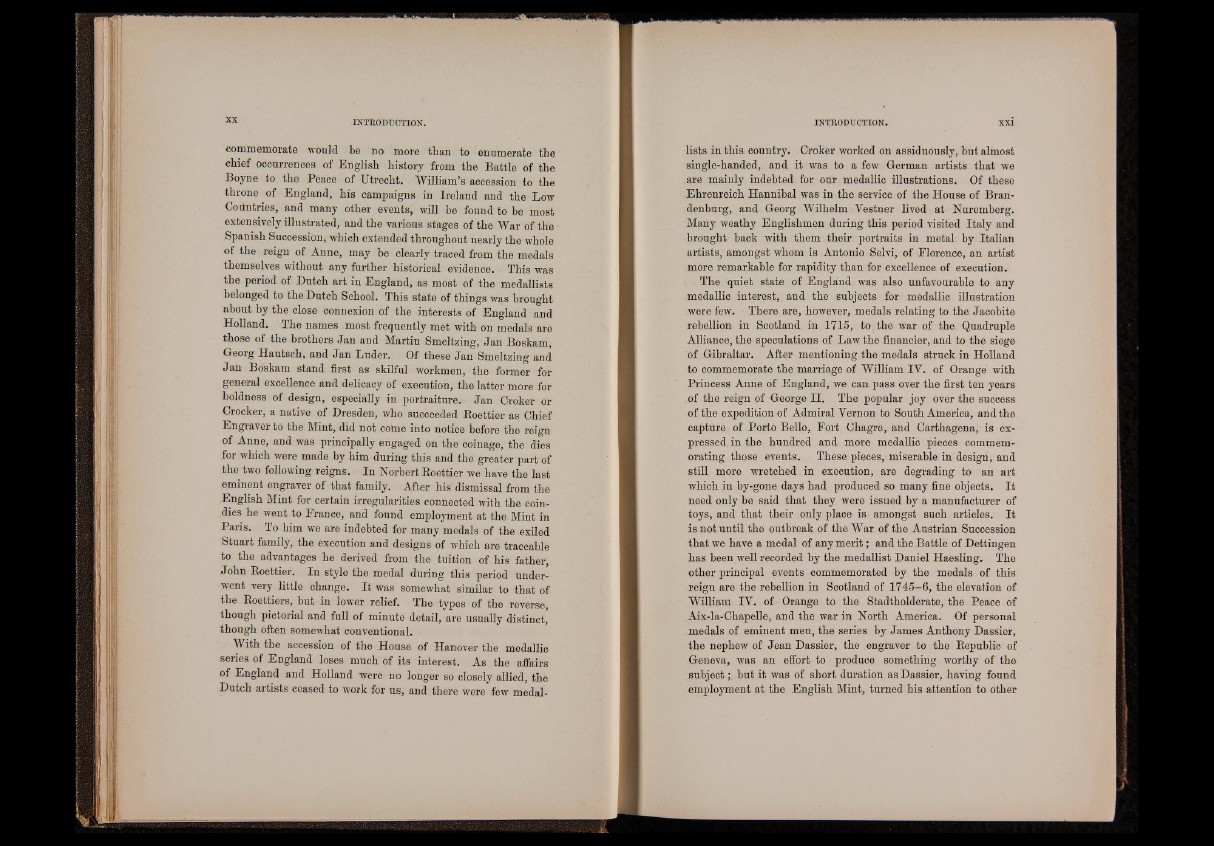
commemorate would be no more than to enumerate tbe
chief occurrences of English history from the Battle of the
Boyne to the Peace of Utrecht. William’s accession to the
throne of England, his campaigns in Ireland and the Low
Countries, and many other events, will be found to be most
extensively illustrated, and the various stages of the War of the
Spanish Succession, which extended throughout nearly the whole
of the reign of Anne, may be clearly traced from the medals
themselves without any further historical evidence. This was
the period of Dutch art in England, as most of the medallists
belonged to the Dutch School. This state of things was brought
about by the close connexion of the interests of England and
Holland. The names most frequently met with on medals are
those of the brothers Jan and Martin Smeltzing, Jan Boskam,
Georg Hautsch, and Jan Luder. Of these Jan Smeltzing and
Jan Boskam stand first as skilful workmen, the former for
general excellence and delicacy of execution, the latter more for
boldness of design, especially in portraiture.- Jan Croker or
Crocker, a native of Dresden, who succeeded Boettier as Chief
Engraver to the Mint, did not come into notice before the reign
of Anne, and was principally engaged on the coinage, the dies
for which were made by him during this and the greater part of
the two following reigns. In Norbert Boettier we have the last
eminent engraver of that family. After his dismissal from the
English Mint for certain irregularities connected with the coindies
he went to France, and found employment at the-Mint in
Paris. To him we are indebted for many medals of the exiled
Stuart family, the execution and designs of which are traceable
to the advantages he derived from the tuition of his father,
John Boettier. In style the medal during this period underwent
very little change. It was somewhat similar to that of
the Boettiers, but in lower relief. The types of the reverse,
though pictorial and full of minute detail, are usually distinct,
though often somewhat conventional.
With the accession of the House of Hanover the medallic
series of England loses much of its interest. As the affairs
of England and Holland were no longer so closely allied, the
Dutch artists ceased to work for us, and there were few medallists
in this country. Croker worked on assiduously, but almost
single-handed, and it was to a few German artists that we
are mainly indebted for our medallic illustrations. Of these
Ehrenreich Hannibal was in the service of the House of Brandenburg,
and Georg Wilhelm Yestner lived at Nuremberg.
Many weathy Englishmen during this period visited Italy and
brought back with them their portraits in metal by Italian
artists, amongst whom is Antonio Selvi, of Florence, an artist
more remarkable for rapidity than for excellence of execution.
The quiet state of England was also unfavourable to any
medallic interest, and the subjects for medallic illustration
were few. There are, however, medals relating to the Jacobite
rebellion in Scotland in 1715, to? the war of the Quadruple
Alliance, the speculations of Law the financier, and to the siege
of Gibraltar. After mentioning the medals struck in Holland
to commemorate the marriage of William IY. of Orange with
Princess Anne of England, we can pass over the first ten years
of the reign of George II. The popular joy over the success
of the expedition of Admiral Yernon to South America, and the
capture of Porto Bello, Fort Chagre, and Carthagena, is expressed
in the hundred and more medallic pieces commemorating
those events. These pieces, miserable in design, and
still more wretched in execution, are degrading to an art
which in by-gone days had produced so many fine objects. It
need only be said that they were issued by a manufacturer of
toys, and that their only place is amongst such articles. It
is not until the outbreak of the War of the Austrian Succession
that we have a medal of any merit; and the Battle of Dettingen
has been well recorded by the medallist Daniel Haesling. The
other principal events commemorated by the medals of this
reign are the rebellion in Scotland of 1745-6, the elevation of
William IV. of Orange to the Stadtholderate, the Peace of
Aix-la-Chapelle, and the war in North America. Of personal
medals of eminent men, the series by James Anthony Dassier,
the nephew of Jean Dassier, the engraver to the Bepublic of
Geneva, was an effort to produce something worthy of the
subject; but it was of short duration as Dassier, having found
employment at the English Mint, turned his attention to other